2016 MITSUBISHI OUTLANDER SPORT window
[x] Cancel search: windowPage 2 of 398
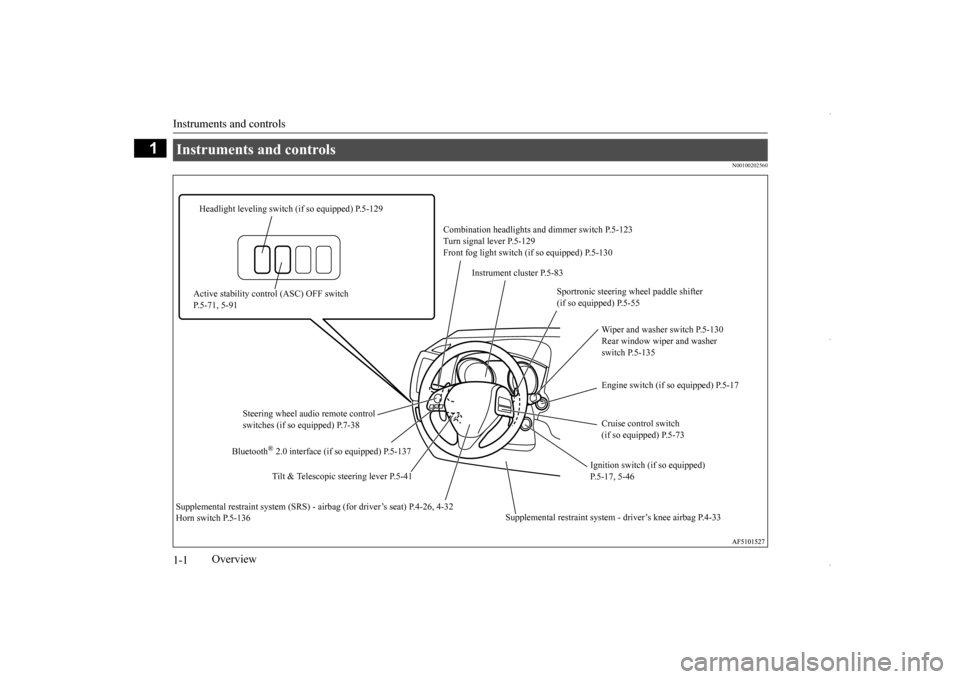
Instruments and controls 1-1
1
Overview
N00100202560
Instruments and controls
Combination headlights
and dimmer switch P.5-123
Turn signal lever P.5-129 Front fog light switch (if so equipped) P.5-130
Headlight leveling switch (if so equipped) P.5-129
Instrument cluster P.5-83
Active stability control (ASC) OFF switch P.5-71, 5-91
Sportronic steering wheel paddle shifter (if so equipped) P.5-55
Wiper and washer switch P.5-130 Rear window wiper and washer switch P.5-135 Engine switch (if so equipped) P.5-17
Steering wheel audio remote control switches (if so equipped) P.7-38
Cruise control switch (if so equipped) P.5-73
Tilt & Telescopic steering lever P.5-41
Ignition switch (if so equipped) P.5-17, 5-46
Bluetooth
® 2.0 interface (if so
equipped) P.5-137
Supplemental restraint system
- driver’s knee airbag P.4-33
Supplemental restraint system (SRS) - ai
rbag (for driver’s seat) P.4-26, 4-32
Horn switch P.5-136BK0229600US.bo
ok 1 ページ 2015年10月1日 木曜日 午後2時29分
Page 3 of 398
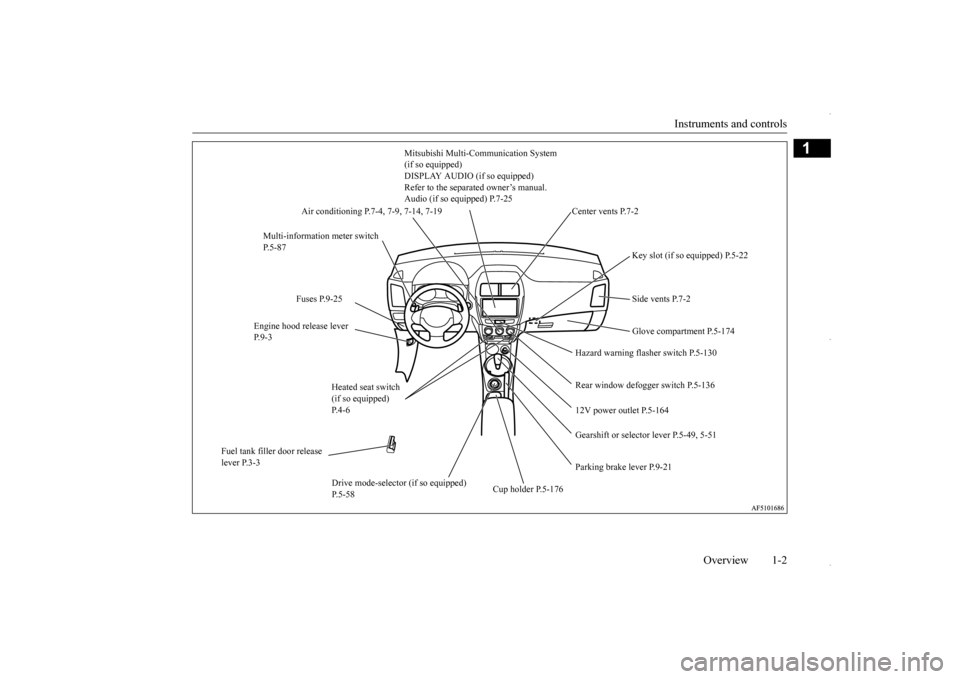
Instruments and controls
Overview 1-2
1
Mitsubishi Multi-Communication System (if so equipped) DISPLAY AUDIO (if so equipped) Refer to the separated owner’s manual.Audio (if so equipped) P.7-25
Multi-information meter switch P.5-87
Key slot (if so equipped) P.5-22 Side vents P.7-2
Fuses P.9-25
Engine hood release lever P.9-3
Glove compartment P.5-174
Hazard warning flasher switch P.5-130 Rear window defogger switch P.5-136
Air conditioning P.7-4, 7-9, 7-14, 7-19
12V power outlet P.5-164 Gearshift or selector
lever P.5-49, 5-51
Fuel tank filler door release lever P.3-3
Parking brake lever P.9-21
Drive mode-selector (if so equipped) P.5-58
Cup holder P.5-176
Center vents P.7-2
Heated seat switch (if so equipped) P. 4 - 6
BK0229600US.bo
ok 2 ページ 2015年10月1日 木曜日 午後2時29分
Page 5 of 398

Interior
Overview 1-4
1
Electric remote-controlled outside mirror switch P.5-44
Lock switch P.5-38
Power door lock switch P.5-30
Supplemental restraint system (SRS) - curtain airbags P.4-37
Power window switch P.5-37
Sunshade illumination lamp dimming control switch (if so equipped) P.5-172
Seat belts P.4-11
Adjustable seat belt shoulder anchor P.4-16
Inside rearview mirror P.5-42 HomeLink
® Wireless Control System (if so
equipped) P.5-165
Tether anchors for child restraint system P.4-21
Front seat P.4-2 Heated seat (if so equipped) P.4-6
Supplemental restraint system (SRS) - side airbag (for front seats) P.4-37
Cargo room light P.5-172
Head restraints P.4-7
BK0229600US.bo
ok 4 ページ 2015年10月1日 木曜日 午後2時29分
Page 7 of 398
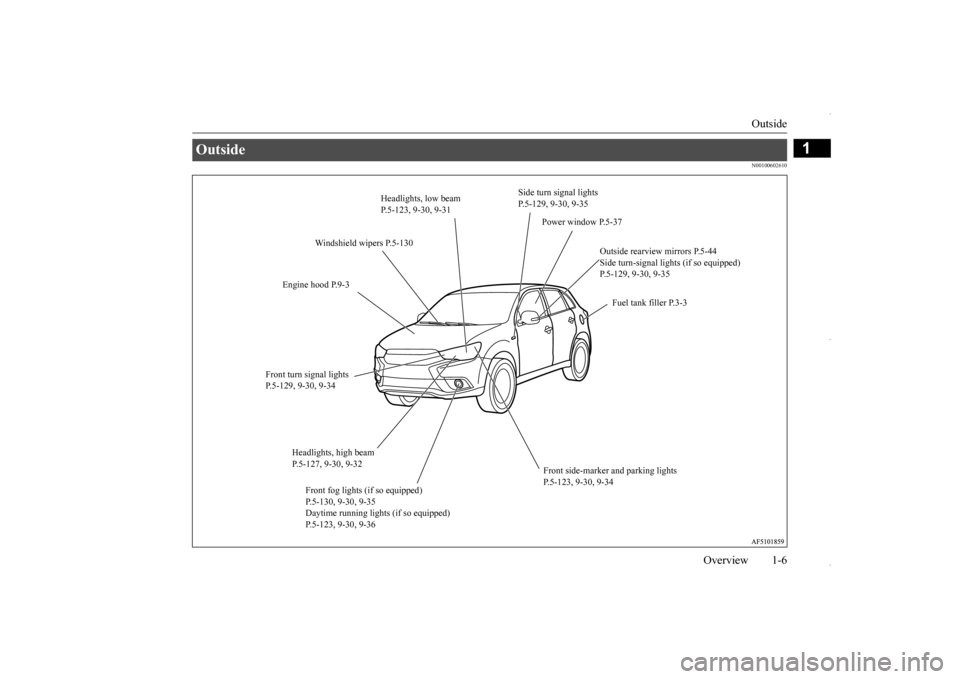
Outside
Overview 1-6
1
N00100602610
Outside
Power window P.5-37
Windshield wipers P.5-130
Engine hood P.9-3
Fuel tank filler P.3-3
Outside rearview mirrors P.5-44 Side turn-signal lights (if so equipped) P.5-129, 9-30, 9-35
Front turn signal lights P.5-129, 9-30, 9-34
Side turn signal lights P.5-129, 9-30, 9-35
Headlights, high beam P.5-127, 9-30, 9-32
Front side-marker and parking lights P.5-123, 9-30, 9-34
Front fog lights (if so equipped) P.5-130, 9-30, 9-35 Daytime running lights (if so equipped) P.5-123, 9-30, 9-36
Headlights, low beam P.5-123, 9-30, 9-31
BK0229600US.bo
ok 6 ページ 2015年10月1日 木曜日 午後2時29分
Page 8 of 398
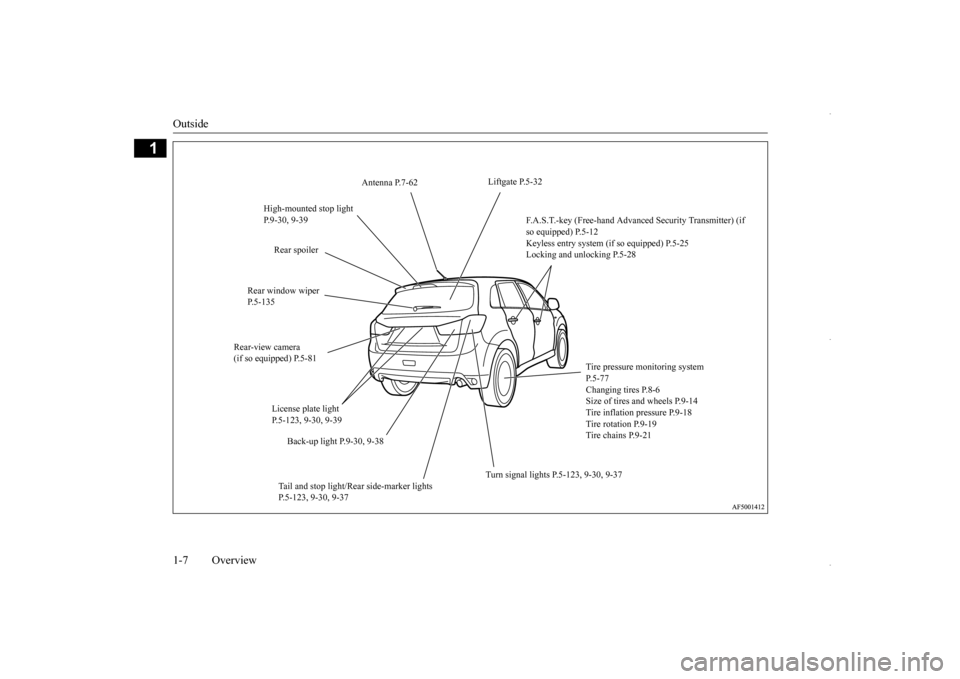
Outside 1-7 Overview
1
Liftgate P.5-32
Antenna P.7-62
High-mounted stop light P.9-30, 9-39
F.A.S.T.-key (Free-hand Advanced Security Transmitter) (if so equipped) P.5-12 Keyless entry system (if so equipped) P.5-25Locking and unlocking P.5-28
Rear spoiler
Rear window wiper P.5-135
Rear-view camera (if so equipped) P.5-81
Tire pressure monitoring system P.5-77Changing tires P.8-6 Size of tires and wheels P.9-14 Tire inflation pressure P.9-18 Tire rotation P.9-19 Tire chains P.9-21
License plate light P.5-123, 9-30, 9-39
Back-up light P.9-30, 9-38
Turn signal lights P.5-123, 9-30, 9-37
Tail and stop light/Rear side-marker lights P.5-123, 9-30, 9-37
BK0229600US.bo
ok 7 ページ 2015年10月1日 木曜日 午後2時29分
Page 12 of 398

If this problem occurs... 2-4 Quick index
2
Cannot shift the selector lever from the “P” (PARK) position. (for vehicles with continuously variable transmission (CVT))
Shift the selector lever while pressing the brake pedal. Check that the ignition switch or the operation mode is in ON.
P. 5-51
The windows are fogged up.
1. Set the mode selection dial to the “ ” or “ ” position. 2. Turn on the blower.
P. 7-8, 7-13, 7-18, 7-23
The engine does not start. The lights do not come on.The lights are dim. The horn does not honk. The horn sound is weak.
Have the battery checked. Recharge or replace as needed.
P. 8-2, P. 9-11
Problem
Do this
Ref. Page
BK0229600US.bo
ok 4 ページ 2015年10月1日 木曜日 午後2時29分
Page 18 of 398

Filling the fuel tank 3-4 General information
3
All-wheel drive vehicles: 15.8 gal (60 L) Front-wheel drive vehicles: 16.6 gal (63 L) 1. Before filling with fuel, stop the engine. 2. The fuel tank filler is located on the rear driver side of your vehicle. The fuel tank filler door can be openedfrom inside the vehicle with the fuel tank filler door release le
ver located at the left
side of the driver’s seat.
3. Open the fuel tank filler pipe by slowly turning the fuel tank filler cap counter- clockwise. 4. While filling with fuel, hang the fuel cap cord on the hook located on the inside of the fuel tank filler door.
5. To fill with fuel correctly depends mainly on correct handling of the fuel filler noz-zle. Do not tilt the nozzle. Insert the noz- zle in the fuel tank filler port as far as it goes. 6. When the nozzle stops automatically, do not try to add more fuel.
Keep the doors and windows closed while refueling the vehicle. If they were open, fuel vapor could get into the cabin.
Fuel tank capacity Refueling
WA R N I N G
1- Remove 2- Close
WA R N I N G Since the fuel system may be under pres- sure, remove the fuel tank filler cap slowly. This relieves any pressure or vac- uum that might have built up in the fuel tank. If the cap is venting vapor or if youhear a hissing sound, wait until the sound stops before removing the cap. Otherwise, fuel may spray out, injuring you or others.CAUTION Your vehicle can only be operated using unleaded gasoline. Serious engine and cata-lytic converter damage will result if leaded gasoline is filled into these vehicles, and consequently, this must never be attempted.CAUTION To avoid fuel spillage
and overfilling, do not
“top-off” the fuel tank. Spilled fuel could discolor, stain, or crack the vehicle’s paint- work. If fuel spills on the paintwork, wipe itoff with a soft cloth.
BK0229600US.bo
ok 4 ページ 2015年10月1日 木曜日 午後2時29分
Page 46 of 398
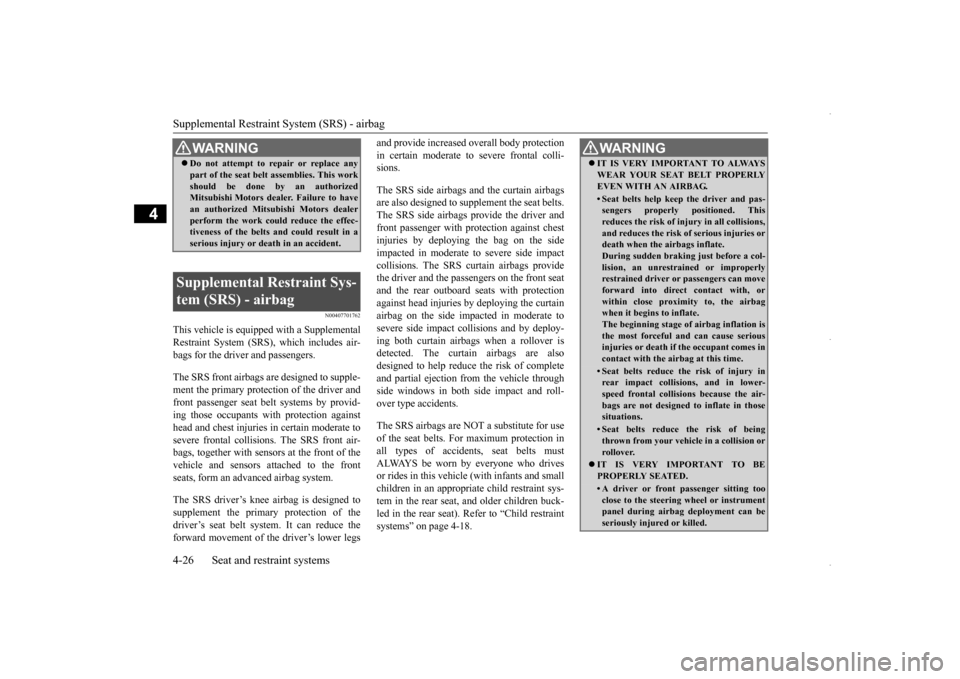
Supplemental Restraint System (SRS) - airbag 4-26 Seat and restraint systems
4
N00407701762
This vehicle is equipped with a Supplemental Restraint System (SRS), which includes air- bags for the driver and passengers. The SRS front airbags are designed to supple- ment the primary protection of the driver andfront passenger seat belt systems by provid- ing those occupants with protection against head and chest injuries in certain moderate tosevere frontal collisions. The SRS front air- bags, together with sensors at the front of the vehicle and sensors attached to the frontseats, form an advanced airbag system. The SRS driver’s knee airbag is designed to supplement the primary protection of the driver’s seat belt system. It can reduce theforward movement of the driver’s lower legs
and provide increased overall body protection in certain moderate to severe frontal colli- sions. The SRS side airbags and the curtain airbags are also designed to supplement the seat belts.The SRS side airbags provide the driver and front passenger with protection against chest injuries by deploying the bag on the sideimpacted in moderate to severe side impact collisions. The SRS curtain airbags provide the driver and the passengers on the front seatand the rear outboard seats with protectionagainst head injuries by deploying the curtain airbag on the side impacted in moderate to severe side impact collisions and by deploy-ing both curtain airbags when a rollover is detected. The curtain airbags are also designed to help reduce the risk of completeand partial ejection from the vehicle through side windows in both side impact and roll- over type accidents. The SRS airbags are NOT a substitute for use of the seat belts. For maximum protection in all types of accidents, seat belts must ALWAYS be worn by everyone who drivesor rides in this vehicl
e (with infants and small
children in an appropriate child restraint sys- tem in the rear seat, and older children buck-led in the rear seat). Refer to “Child restraint systems” on page 4-18.
WA R N I N G Do not attempt to repair or replace any part of the seat belt assemblies. This work should be done by an authorized Mitsubishi Motors dealer. Failure to have an authorized Mitsubishi Motors dealerperform the work could reduce the effec- tiveness of the belts and could result in a serious injury or death in an accident.
Supplemental Restraint Sys- tem (SRS) - airbag
WA R N I N G IT IS VERY IMPORTANT TO ALWAYS WEAR YOUR SEAT BELT PROPERLY EVEN WITH AN AIRBAG.• Seat belts help keep the driver and pas-sengers properly positioned. This reduces the risk of injury in all collisions, and reduces the risk of serious injuries ordeath when the airbags inflate. During sudden braking just before a col- lision, an unrestrained or improperlyrestrained driver or passengers can move forward into direct contact with, or within close proximity to, the airbagwhen it begins to inflate. The beginning stage of airbag inflation is the most forceful and can cause seriousinjuries or death if the occupant comes in contact with the airbag at this time.• Seat belts reduce the risk of injury inrear impact collisions, and in lower- speed frontal collisions because the air-bags are not designed to inflate in those situations.• Seat belts reduce the risk of beingthrown from your vehicle in a collision or rollover.
IT IS VERY IMPORTANT TO BE PROPERLY SEATED.• A driver or front passenger sitting tooclose to the steering wheel or instrument panel during airbag deployment can be seriously injured or killed.
BK0229600US.bo
ok 26 ページ 2015年10月1日 木曜日 午後2時29分